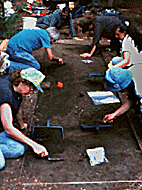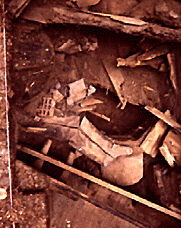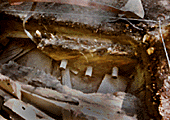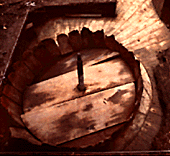Cornish Buddles Unearthed at a Michigan Copper Mine
The copper mines of Michigan's Keweenaw Peninsula were
America's most important source of copper for most of the 19th century.
Copper in this region exists in its native metallic state, unalloyed with
other minerals. Large-scale development of the district began in the 1840s,
when a geologist's report on the prospects of the area helped spawn a
mineral rush. Numerous companies bought tracts of land and sent crews
to begin exploratory work. Cornish mining technology came to the region
with immigrant miners and was a key factor in the district's development.
The organization of underground work and the stamping and washing practices
all drew on Cornish precedents. A small number of mines, the Cliff, the
Minesota [sic], and later the Quincy, and the Calumet & Hecla, were
very productive and profitable. Most of the early ventures were not so
successful and expended the investors money without returning a profit.
 Michigan Technological University students and
faculty, Ottawa National Forest archaeologists, and volunteers have been
researching one of the early failures, the Ohio Trap Rock mine, for several
years. Mining began at the site in 1847, and by 1858 the original company
had expended its capital and closed down. Other companies continued to
work the same copper veins, but appear not to have used Ohio Trap Rock's
surface works. Over the last four years we have mapped the site, surface
collected approximately 10 acres (primarily the domestic area of the site),
test excavated three structures, and studied historic information about
the site. The most extensive excavations have taken place at the company's
stamp mill, one of 35 surface buildings the company constructed . At the
stamp mill mine rock was crushed and washed to liberate small grains of
copper. The mill at Ohio Trap Rock was apparently built in 1852, and was
probably out of use by 1858. The mill had 24 stamp heads run off a 40
horsepower steam engine. Over the past three seasons we excavated 19 test
units covering 56 m2 of the structure. The combination of archaeological
and historical research has given us a very good idea about the construction,
layout, and organization of this early mill.
Michigan Technological University students and
faculty, Ottawa National Forest archaeologists, and volunteers have been
researching one of the early failures, the Ohio Trap Rock mine, for several
years. Mining began at the site in 1847, and by 1858 the original company
had expended its capital and closed down. Other companies continued to
work the same copper veins, but appear not to have used Ohio Trap Rock's
surface works. Over the last four years we have mapped the site, surface
collected approximately 10 acres (primarily the domestic area of the site),
test excavated three structures, and studied historic information about
the site. The most extensive excavations have taken place at the company's
stamp mill, one of 35 surface buildings the company constructed . At the
stamp mill mine rock was crushed and washed to liberate small grains of
copper. The mill at Ohio Trap Rock was apparently built in 1852, and was
probably out of use by 1858. The mill had 24 stamp heads run off a 40
horsepower steam engine. Over the past three seasons we excavated 19 test
units covering 56 m2 of the structure. The combination of archaeological
and historical research has given us a very good idea about the construction,
layout, and organization of this early mill.
 The 1994 and 1995 excavations centered on portions
of the washing and laundering system where the copper was concentrated
after the rock was crushed. Most of the test units had very similar stratigraphy.
The first 5-10 cm were a dark brown mat of roots and decaying twigs, leaves,
pine needles, and other organic matter. Beneath this organic layer was
sand, the byproduct of the stamping process of the mill. The sand was
olive green, and ranged in consistency from silty-sand to very coarse
sand. The residual copper in the stamp sand sediments acted as a biocide
and contributed to excellent organic preservation. Wood, leather, and
other organic materials in the sand were well preserved, and the buried
wooden components of the structure were in virtually perfect condition.
The 1994 and 1995 excavations centered on portions
of the washing and laundering system where the copper was concentrated
after the rock was crushed. Most of the test units had very similar stratigraphy.
The first 5-10 cm were a dark brown mat of roots and decaying twigs, leaves,
pine needles, and other organic matter. Beneath this organic layer was
sand, the byproduct of the stamping process of the mill. The sand was
olive green, and ranged in consistency from silty-sand to very coarse
sand. The residual copper in the stamp sand sediments acted as a biocide
and contributed to excellent organic preservation. Wood, leather, and
other organic materials in the sand were well preserved, and the buried
wooden components of the structure were in virtually perfect condition.
The sill of the washing house, sections of working floor, drainage and
supply trenches, a classifying or jigging area, and sections of two circular
buddles were all found in the excavations. The mill burned, and there
were many charred wooden pieces of the structure that had fallen down
and been buried. The most striking example was a portion of a wooden door
. This was constructed of several layers of planks held together with
clenched nails, and still had a fragment of a hinge attached. Only the
bottom of the door remained, as the upper portion had burned away. This
door remnant was lying on top of a preserved section of wooden floor,
which also yielded several intact barrel bottoms.
 Nails, bolts, washers, spikes, window glass, pieces of lumber,
and other architectural artifacts were scattered throughout the stamp
sand deposits. Two major artifact concentrations were also excavated.
One was a mix of fill, trash, and destruction rubble that contained several
copper alloy brackets, barrel parts, textiles, sections of metal pipe,
and a host of other artifacts. The second concentration was in the fill
of one of the drainage trenches. This contained many well preserved organic
artifacts including textile fragments, several pieces of leather boots
or leather leggings, and several sections of wooden trough. It also contained
half of a metal-bound wooden crown gear. The gear was originally about
a meter in diameter with projecting wooden pegs around the edge to engage
another gear. This might have been part of the drive mechanism to power
the sweeps on one of the buddles.
Nails, bolts, washers, spikes, window glass, pieces of lumber,
and other architectural artifacts were scattered throughout the stamp
sand deposits. Two major artifact concentrations were also excavated.
One was a mix of fill, trash, and destruction rubble that contained several
copper alloy brackets, barrel parts, textiles, sections of metal pipe,
and a host of other artifacts. The second concentration was in the fill
of one of the drainage trenches. This contained many well preserved organic
artifacts including textile fragments, several pieces of leather boots
or leather leggings, and several sections of wooden trough. It also contained
half of a metal-bound wooden crown gear. The gear was originally about
a meter in diameter with projecting wooden pegs around the edge to engage
another gear. This might have been part of the drive mechanism to power
the sweeps on one of the buddles.
 The remains of two circular convex wooden buddles
are the most interesting discovery. Each of these had a vertical metal
shaft in the center, surrounded by vertical planking approximately 55
cm out from bearing. Outside the vertical planking was a horizontal wooden
floor that sloped down slightly away from the center. The floor was made
of wood planks radiated out from the center of the buddle. These were
tongue-and-grooved together, and cut with a taper so that they widened
towards the edge of the buddle. The outside edge of floor was not truly
round, but polygonal. Vertical planking about 25 cm high was attached
to the exterior edge. Floor butted up against the vertical planking on
one side, and in
The remains of two circular convex wooden buddles
are the most interesting discovery. Each of these had a vertical metal
shaft in the center, surrounded by vertical planking approximately 55
cm out from bearing. Outside the vertical planking was a horizontal wooden
floor that sloped down slightly away from the center. The floor was made
of wood planks radiated out from the center of the buddle. These were
tongue-and-grooved together, and cut with a taper so that they widened
towards the edge of the buddle. The outside edge of floor was not truly
round, but polygonal. Vertical planking about 25 cm high was attached
to the exterior edge. Floor butted up against the vertical planking on
one side, and in  another area a wood-lined trench was next to
the edge of the buddle. The trench seems to have been designed to help
drain water and fine sand out of the buddle. We excavated from the center
of one buddle across to the outside edge, and it proved to be about 9
meters in diameter .
another area a wood-lined trench was next to
the edge of the buddle. The trench seems to have been designed to help
drain water and fine sand out of the buddle. We excavated from the center
of one buddle across to the outside edge, and it proved to be about 9
meters in diameter .
 In 1851 the Ohio Trap Rock company fired the English mine captain
who was their on-site agent, and hired an experienced Cornish miner, Captain
Joseph Buzzo, in his place. Buzzo tripled the workforce to more than 100
workers and directed the construction of additional surface facilities.
It is likely that Buzzo and Cornish miners he hired built the stamp and
washing house. The wooden buddles at this site represent a serious investment
of time and effort, yet they were only in use for a few years before the
company shut down. Circular buddles are a distinctly Cornish style technology,
and were the leading edge of ore dressing technology in the 1850s. This
technology was not well known in North America. The presence of these
buddles at the Ohio Trap Rock mine site shows the early transfer of Cornish
copper processing techniques to Michigan's Keweenaw Peninsula.
In 1851 the Ohio Trap Rock company fired the English mine captain
who was their on-site agent, and hired an experienced Cornish miner, Captain
Joseph Buzzo, in his place. Buzzo tripled the workforce to more than 100
workers and directed the construction of additional surface facilities.
It is likely that Buzzo and Cornish miners he hired built the stamp and
washing house. The wooden buddles at this site represent a serious investment
of time and effort, yet they were only in use for a few years before the
company shut down. Circular buddles are a distinctly Cornish style technology,
and were the leading edge of ore dressing technology in the 1850s. This
technology was not well known in North America. The presence of these
buddles at the Ohio Trap Rock mine site shows the early transfer of Cornish
copper processing techniques to Michigan's Keweenaw Peninsula.
Email | Phone: (906) 487-2113 | Fax: (906) 487-2468